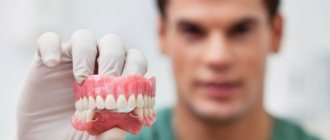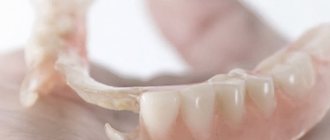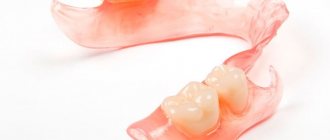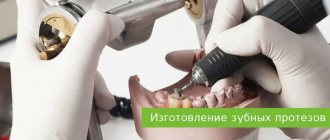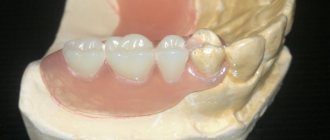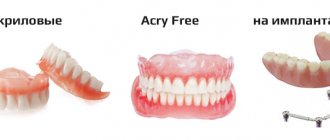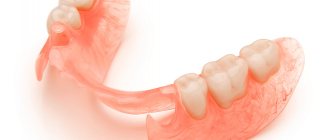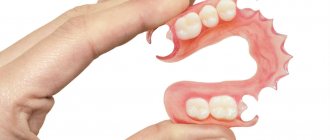In many cases, a denture is a solution to the problem of missing several teeth in a row. At the same time, the choice in prosthetic instruments is so great that patients can afford orthodontic devices of a wide variety of designs, different materials and price categories. As you know, all prosthetic devices are divided into removable and non-removable. The latter are distinguished by a more rigid permanent fixation, but removable dentures become optimal for many, since they allow the dental structure to be removed if necessary.
Even if the removable denture was made from expensive materials by the best specialists (as in the LeaderStom clinic), then even in this case, there may be voids in some places between the prosthetic device and the gum tissue, and abrasions or areas of increased pressure on the gum in others. This fact is not considered a defect or defect of dentists: the fact is that such minimal defects are eliminated themselves during the period of adaptation to the prosthesis, or by using special fixing agents and materials.
Fixing cream
Adhesive (fixing) preparations are available in the form of creams, powders or fiber pads. The most popular among them are creams that are produced on the basis of water-soluble polymer materials. They are easy to use, have additional antiseptic and aromatic properties and allow the patient to completely eliminate defects in the prosthetic device at the same time as more durable fixation. Manufacturers additionally add anti-inflammatory oils to some creams, which have a beneficial effect on the condition of the gums.
The principle of using a fixing cream is quite simple: immediately before applying the cream, you need to thoroughly rinse the prosthetic device and brush your teeth. Then a small amount of fixing cream is applied to the inside of the denture base. The device is placed on the teeth and pressed lightly for five to seven minutes. The adhesive preparation is completely compatible with biological tissues of the oral cavity, its composition is natural and does not cause allergies.
An essential feature that all patients need to be aware of is the condition of healthy gums. Any acute or chronic inflammation of the soft tissues of the oral cavity requires the owner of the prosthesis to temporarily refrain from using the orthodontic device and its fixing agents.
Cream "Rox" for dentures
Another popular means for fixing dentures is Rox cream. This is a joint development of domestic and European specialists, capable of holding a removable structure for 12 hours even when drinking hot drinks. The mint extracts included in the composition freshen breath for a long time.
Among the features of the cream are:
- No dyes or zinc, which makes it safe for long-term use.
- Suitable for prostheses made of various materials. Rox glue is suitable for fixing dentures made of plastic, nylon and other composites.
- Economical. Due to the dense structure of the cream, consumption is minimal. One tube will last approximately 1.5-2 months.
- Application. Rox cream can be applied to both dry and wet dentures. This does not affect the quality of fixation.
- Availability. You can buy Rox cream for dentures in almost every pharmacy or supermarket.
The production of fixatives for dentures continues to develop, and new, better quality creams appear periodically. It is quite difficult to keep track of this on your own. Therefore, if you want to choose the best cream for fixing dentures, consult your dentist.
Fixing spacers
This remedy is most often used during the first weeks of wearing a prosthetic structure. Accustoming to a foreign product in the oral cavity occurs differently in different patients. Some experience increased salivation, while others experience discomfort and problems chewing food. Products made of soft fibrous fabric allow you to very carefully fix the prosthesis on the gum. At the same time, they attach well, do not change the bite and protect the gum tissue from rubbing or pressure from the prosthesis. Before applying the fixing gasket, it should be immersed in warm water to wet it. As soon as the product is saturated with water, it can be placed on the inner surface of the prosthesis.
The main indications for using a fixing gasket are:
- significant deformation of the gums as a result of prolonged absence of teeth;
- individual features of the jaw structure;
- atrophic changes in the bone tissue of the upper or lower jaws.
Experts recommend changing retaining pads daily and not neglecting the rules of oral hygiene. It is necessary to regularly clean both the gums and teeth, and the prosthetic device itself. Otherwise, if there are food residues or oil stains on the base of the prosthesis, the gasket will not be fully fixed.
Patients who use this type of prosthesis fixation recognize its obvious advantages:
- protection of the gums from contact with polymer materials of the prosthesis;
- long-lasting and high-quality fixation for 8 hours;
- absence of allergic reactions and irritation of gum tissue;
- effective correction of tissue adhesion during gum deformation;
- antiseptic and aromatic additional effect.
How to know when it’s time to change your dentures
It is recommended to change dentures every 3-5 years or 5-7 years (depending on the material and type of construction).
When using removable dentures, the load from chewing food on bone tissue is only insignificant, which is fraught with its gradual resorption. The jawbone decreases in size, and not always evenly. This process takes from six months to several years and leads to a discrepancy between the shape of the prosthesis and the relief of the gums - the prosthesis is less secure and becomes less stable. This means relocation (if possible) or complete replacement of the structure is required.
In addition, materials wear out over time under the influence of saliva, nicotine, food irritants, and mechanical stress. Cracks appear on the structure, the surface becomes less smooth, which contributes to the accumulation of a large amount of plaque. If you have chosen crowns made of plastic (namely, they are in most cases used in removable orthopedic devices), it is worth considering that they wear down quite quickly, so after about 2-3 years the bite changes, which can affect the condition of the joint and the process of normal chewing food.
Fixing powder
It is made from sodium alginate, which contains natural substances that are biologically compatible with living gum tissue. The principle of using the powder is the same as that of a cream or fixing pad. A small amount of fixing powder is applied to the previously cleaned denture, the device is immediately put on the teeth and bonding occurs. Fixing powder, unlike fixing creams or pads, is usually available without aromatic or flavoring additives.
Possible options
If the old crown can be used, it will be reinstalled using fresh temporary dental cement. The patient will have the opportunity to wear the crown again for some time; if discomfort does not arise, the fixation will be performed with permanent cement. If wearing it is impossible, the dentist will offer to make a new crown and give reasons for his recommendations.
Minor damage to the crown (chips) can be repaired. Significant damage cannot be repaired. A new product will need to be manufactured.
Recommendations for getting used to a prosthetic device
Dentist specialists from the LeaderStom network of clinics believe that the process of adaptation to a prosthetic device takes on average up to 2 months. The most difficult of them are the first two weeks. During this period, symptoms such as:
- difficulty speaking;
- difficulties with chewing and swallowing, leading to a gag reflex;
- sensation of sore gums or general discomfort from fixing the prosthesis;
- increased salivation.
The advantage of a removable denture is that in case of severe discomfort, the device can always be removed for a short time and rest. At first, it is recommended to wear the prosthetic device not during meals, but in the intervals between meals. The next stage of adaptation will be putting on the prosthesis at night. When the body has already gotten a little used to it, you can move on to fixative drugs.
With increased salivation, sucking candies are very helpful because they stimulate the swallowing reflex. It is recommended to drink plenty of water in small sips to teach the body to swallow with the presence of a prosthetic device.
During the period of adaptation to the prosthesis, you should adhere to a gentle diet and exclude solid foods. Do not worry if the installation of a removable denture has a negative impact on the taste of food. This is a quite common symptom that goes away on its own after two weeks of using the prosthesis and does not depend in any way on the fixation agent.
Difficulties in speaking while wearing a denture are also temporary, but most patients will need to work on it a little. The best way is to read aloud. If you have grandchildren, then bedtime stories will not only be useful for them, but also effective practice for your pronunciation.
In rare cases, wearing a prosthesis causes so-called individual intolerance, when psychological discomfort exceeds physical discomfort. However, such a diagnosis can only be made after 2-3 weeks, when at the physiological level the adaptation of the prosthetic device has been successful, but the patient still continues to experience severe discomfort. In such a situation, you can simply postpone wearing the prosthesis and wait for a more favorable moment. There are many cases where the prosthesis “took root” two to three months after its first installation and fixation.
Medical Internet conferences
The purpose of our study is to review means for fixation of complete dentures.
In this work we set ourselves the following tasks:
-describe the properties and composition of means for fixing complete removable dentures;
- analyze the physical and chemical properties of gels for fixing complete removable dentures;
-conduct a review of the market for means for fixing complete removable dentures presented in pharmacy chains, dental stores and clinics;
- analyze data to assess adhesive strength.
Materials and methods:
— familiarization with the literature on this topic;
— study of experimental data to assess adhesive strength, according to the methodology of S.E. Zholudev.
Results:
The problem of complete removable prosthetics is the quality of fixation of dentures in the oral cavity [5]. If it is impossible to achieve functional suction during the manufacture of complete removable dentures, it is advisable to recommend that patients use additional means to improve the fixation and stabilization of dentures [1]. Adhesive compositions for removable laminar dentures have the following properties:
— reliable and durable fastening of prostheses throughout the day,
- preventing food debris from getting under the prosthesis,
— reducing the risk of developing inflammatory processes.
Most fixing adhesive preparations are made on the basis of water-soluble polymers: natural polysaccharide - sodium algiinate; artificial and synthetic components of carboxymethylcellulose (CMC), a mixture of sodium-calcium salts of methyl vinyl ether copolymer of maleic anhydride (MVE/MA); polyglyceryl methacrylate and combinations of the above components with the inclusion of various components with antiseptic, refreshing, aromatizing, analgesic, and antimicrobial effects [10].
The use of fixation agents with appropriate pharmacological preparations makes it possible to treat fungal infections of the tissues of the prosthetic bed if indicated [3]. Prosthetic fixation products are easy to use. The action of these products is based on the universal physical phenomenon of wettability. This can be seen in the following example. If two dry glasses are placed on top of each other, they can be easily separated. Adhesion increases many times if the glass is moistened with water. The same applies if there is a layer of oral fluid (saliva) or adhesive agents between the prosthesis and the mucous membrane [4].
Natural resins, especially Kagaua resin, were used as the first fixing agents [7]. Later, carboxymethyl cellulose was used for these purposes. In 1970, Richardson-Wicke introduced Gantrez and its bivalent salts. Gantrez is a copolymer of vinyl methyl ether with maleic anhydride and has two advantages:
- bioadhesion, causing adhesion to the oral mucosa;
- a strong bond between the copolymer chains, leading to strengthened bonds in the substance itself [9].
There are a large number of means for fixing dentures, presented in pharmacy chains, dental stores and clinics in Saratov. The market includes such companies as ROCS, LACALUTdent, Protefix, Fittydent, PresiDENT, Corega. Creams are very popular. Another common means of securing dentures in the mouth are powders. They, unlike creams, are used for low salivation. Fixing strips are used for abnormal jaw structure [6].
One of the criteria for assessing the quality of orthopedic treatment of patients with complete absence of teeth is good fixation and stabilization of dentures [5].
For a comparative assessment of the adhesive ability of adhesives using laboratory methods, the following technique was used [2].
The degree of adhesion was assessed directly on removable dentures, strengthened with adhesive agents on plaster models reproducing the anatomical shape of the prosthetic bed (Fig. 1).
Rice. 1. Study of the degree of adhesion on jaw models
The studies were carried out on three different plaster models of jaws; the surface of the prosthesis adjacent to the prosthetic bed was treated with adhesive; the area of this surface averaged 29.3 cm2.
To recreate more natural conditions of the prosthetic bed, a plaster model was smeared with a diluted (3%) gelatin solution of the same volume before each experiment and dried for 30 minutes at 100-1200C. Then, a 2 kg weight was used for 5 minutes to ensure a tight fit of the prosthesis. The plaster model was fixed in a tripod and then, when adding a load, the mass was determined at which the prosthesis separated from the prosthetic bed of the model (Fig. 1).
The experiment was repeated until the results converged satisfactorily (the relative error was 7%). Adhesive strength (A) was calculated as the quotient of load in grams (M) per area (S):
A = M / S, g / cm.2
Laboratory methods made it possible to evaluate the adhesive ability of products to improve the fixation of prostheses in relation to the acrylic material of the prosthesis base, as well as to identify the influence of the aqueous environment on adhesive properties over time.
The technique was more consistent with the clinical situation and made it possible to assess the adhesiveness in relation to the prosthetic bed, taking into account the factor of anatomical retention. The adhesive ability of the proposed system (25% propolis) in relation to Pectafix, Lacalutdent, SUPER COREGA Haft-Pulver is initially higher and decreases after 1 hour.
The fixation of complete removable dentures of the upper jaw was assessed directly in the oral cavity in 32 patients. The force of fixation of the prosthesis along line “A” was compared, for which a metal plate was fixed to the prosthesis on self-hardening plastic (Fig. 2).
Rice. 2. An upper jaw prosthesis with a metal plate fixed to self-hardening plastic to determine the fixation force.
A nylon thread was tied to the outer tip of the metal plate, passing it through a roller for unhindered sliding. The prosthesis with an adhesive agent applied to its inner surface was introduced into the oral cavity and pressed tightly against the prosthetic bed for five minutes. Then fine metal shot was evenly added to a reservoir specially attached to the thread (Fig. 3).
The weight of the load at which the prosthesis separated from the prosthetic bed was determined on electronic scales. The study was carried out with a minimally open oral cavity of up to 0.8 cm. Four adhesive agents were compared: “PresiDENT Garant”; "Lacalut dent"; "Dentipur"; "Tizol with propolis." The patient's head was oriented so that the nasal line made a right angle with the piece of thread that was directly fixed to the load reservoir. In one visit, the patient was determined by the strength of fixation of the prosthesis without adhesive, and with the application of one adhesive preparation to the prosthesis. To determine the strength of fixation of a removable structure with a different adhesive, the patient was prescribed at least 24 hours later.
Rice. 3. Patient with a prosthesis fixed in the oral cavity and prepared containers for metal shot
It was noted that the following pattern was observed in each patient:
1. Fixation of the prosthesis, compared with the initial value without adhesive, statistically significantly increases after five minutes when using Tizol with propolis by an average of 500 ± 45 g, that is, half the initial fixation force obtained when measured without an adhesive.
2. The fixation force of the adhesive based on Tizol with propolis is on average 285±30 g (from 190 to 380 g) greater than the fixation force of the adhesives compared in the experiment with the exception of “Lacalutdent”.
AB Klychkov (2002) proved that the use of adhesive materials ensures the stability of dentures on edentulous jaws and affects not only the functional and anatomical characteristics of the maxillofacial area, but also the physicochemical and metabolic parameters of the oral fluid [8].
Conclusions:
-described the properties and composition of means for fixing complete removable dentures, on the basis of which we can conclude that they are an integral part when using complete removable dentures;
- analyzed the physicochemical properties of gels for fixing complete removable dentures, from which we can conclude that the most important property of gels is bioadhesion;
-conducted a review of the market for means for fixing complete removable dentures presented in pharmacy chains, dental stores and clinics, and patients give their preference to creams for fixing complete removable dentures;
- analyzed data on assessing adhesive strength and found that fixation of the prosthesis without adhesive is less effective than using adhesive.
Features of prosthesis care
The presence of a prosthesis-fixing material does not relieve the patient from the procedure of daily cleaning of the dental structure. The effect of adhesive materials is calculated from several hours to one day.
In the morning and evening, the denture should be thoroughly rinsed and cleaned with a special soft brush. Experts recommend not using toothpastes with abrasives when brushing. Even if your denture is made of high-quality ceramic, harsh cleaning particles can damage it with daily use. Remains of fixing cream or powder can be easily removed using regular children's toothpaste. For those who prefer the best protection of their prosthesis from germs and dirt, there are specially designed tablets. They are dissolved in a glass of water where the prosthetic device is placed and left overnight for a cleansing effect.
You don’t have to endure the discomfort of a prosthetic device alone—contact your dentist at the slightest sign of chafing or pain. The prosthetic device itself can be subject to correction, its functional qualities can be adapted individually to the patient. And then the period of adjustment will become easy and pleasant for you, and fixing drugs will help you adapt even faster to your new life with new teeth.
What to do if the prosthesis rubs and does not fit well
- use ointments (Solcoseryl, Metrogyl Denta) or sea buckthorn oil. Apply the oil to the gums for a maximum of 20 minutes after eating and cleaning the denture 3-4 times a day,
- It is forbidden to sharpen dentures yourself, after which you can simply throw it away,
- If there is acute and constant pain caused by rubbing of the structure, you should consult a doctor for correction. 2-3 hours before the visit, the denture should be in the mouth so that the reason why the structure is rubbing becomes visible.
If the device is not fastened well, then you should contact your attending physician - an orthopedic dentist. If the correction does not help, you will have to use special fixation creams: Protefix, Corega, Lacalut Dent. Choose the one that suits you - according to taste, consistency, fixation time. Try different options and choose the best one.
Starting to choose a cream
Despite the wide variety of types of fixing agents, only 6 manufacturers are the most popular on the market. Let's consider each of them separately to have an idea of the composition, properties and cost. The table below provides a brief overview.
Table. Review of the best fixing creams.
| Name of cream, photo | Description |
| This drug is distinguished by its anti-allergenic chemical composition, because each product from this manufacturer does not contain any substances that can provoke an allergic reaction. But it is still not recommended to apply cream to the surface of the prosthesis more than 2 times a day, and before each procedure it is necessary to remove all its residues. Proper use will not lead to any negative reactions. The average cost of the drug on the market ranges from 180-300 rubles. | |
| Another effective remedy that creates a special layer on the mucous membrane. This layer is able to protect the oral cavity from food debris entering the lumen above the structure. The great popularity of the cream is due to its low price and good chemical composition. In addition, this cream does not provoke the development of allergic reactions. The average cost is from 200 to 250 rubles. | |
| One of the most popular fixatives, which still has some side effects. For example, patients with highly sensitive gums complain of severe burning. In this case, experts recommend waiting about 15 seconds after applying the cream and only then installing the prosthesis. The average cost of the cream varies between 190-240 rubles. | |
| The cream is slightly different from others, since manufacturers present it on the market in several versions, so you can choose the product that best suits the consumer. For example, you can buy a cream for sensitive gums - it has a pleasant aroma and neutral taste. After application, the effect of the product lasts about 12 hours. The average cost is 320-440 rubles. | |
| A very effective tool that can easily adapt to the use of a new design if you suddenly decide to change your prosthesis to a more modern or expensive one. With its help, you can securely fasten dentures for 24 hours, while protecting the oral mucosa from rubbing thanks to the created protective layer. The average cost of the cream is from 300 to 360 rubles. | |
| An excellent fixing agent from a Swiss manufacturer that provides reliable fixation of the prosthesis for 12 hours. In addition, the fastening is not weakened by hot drinks or food. If the cream is distributed evenly over the surface of the prosthesis, this will protect the soft tissues from the penetration of moisture or food particles. The cream contains components based on mint and menthol, so throughout the day the patient feels a menthol odor from his breath. The average cost varies in the range of 220-380 rubles. |
